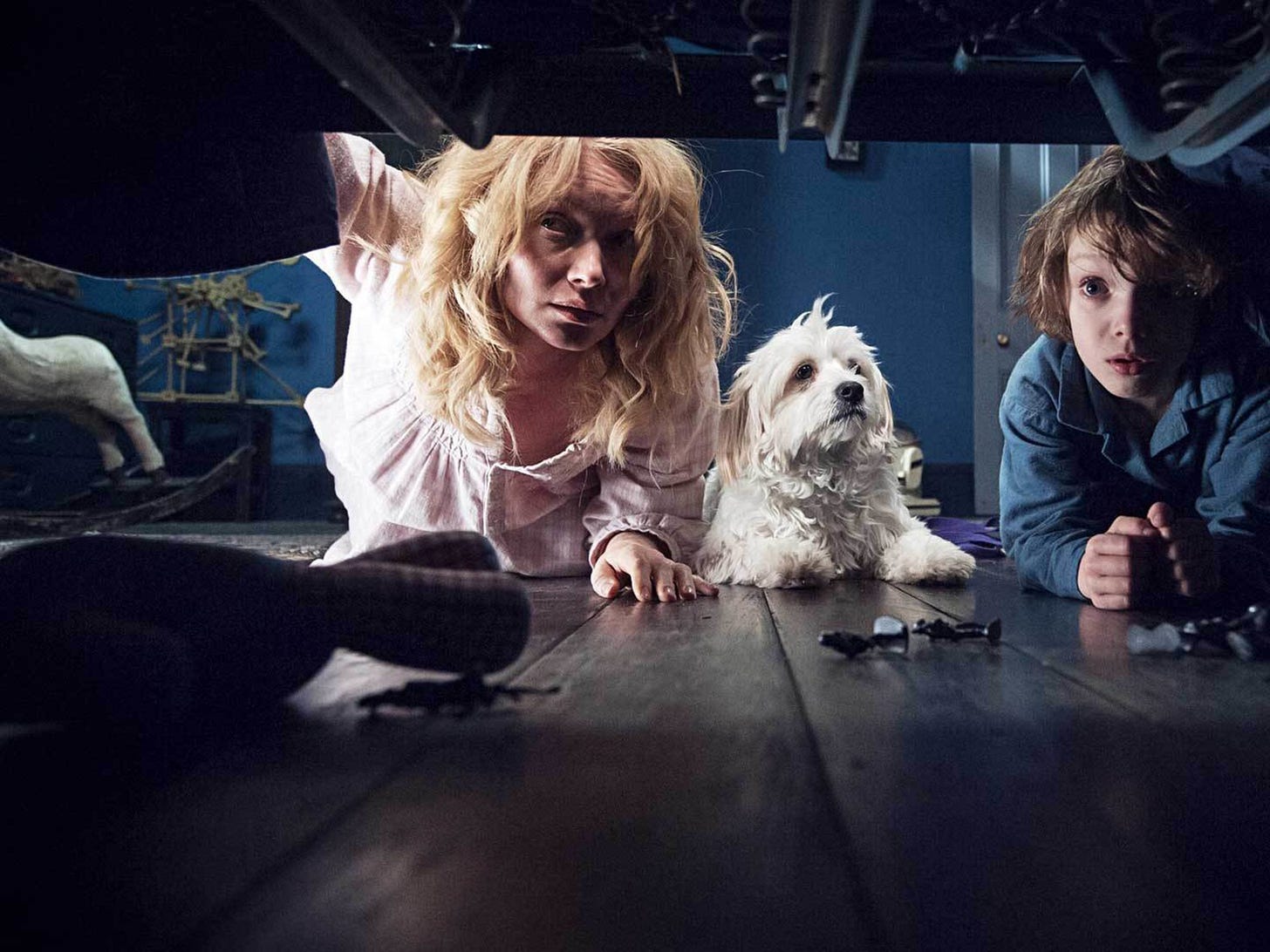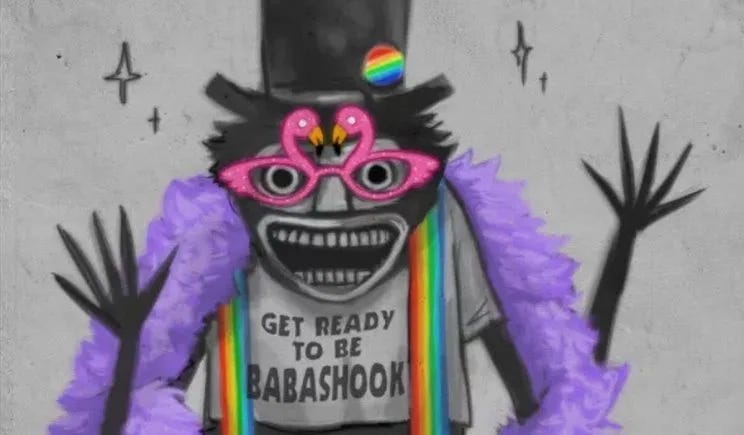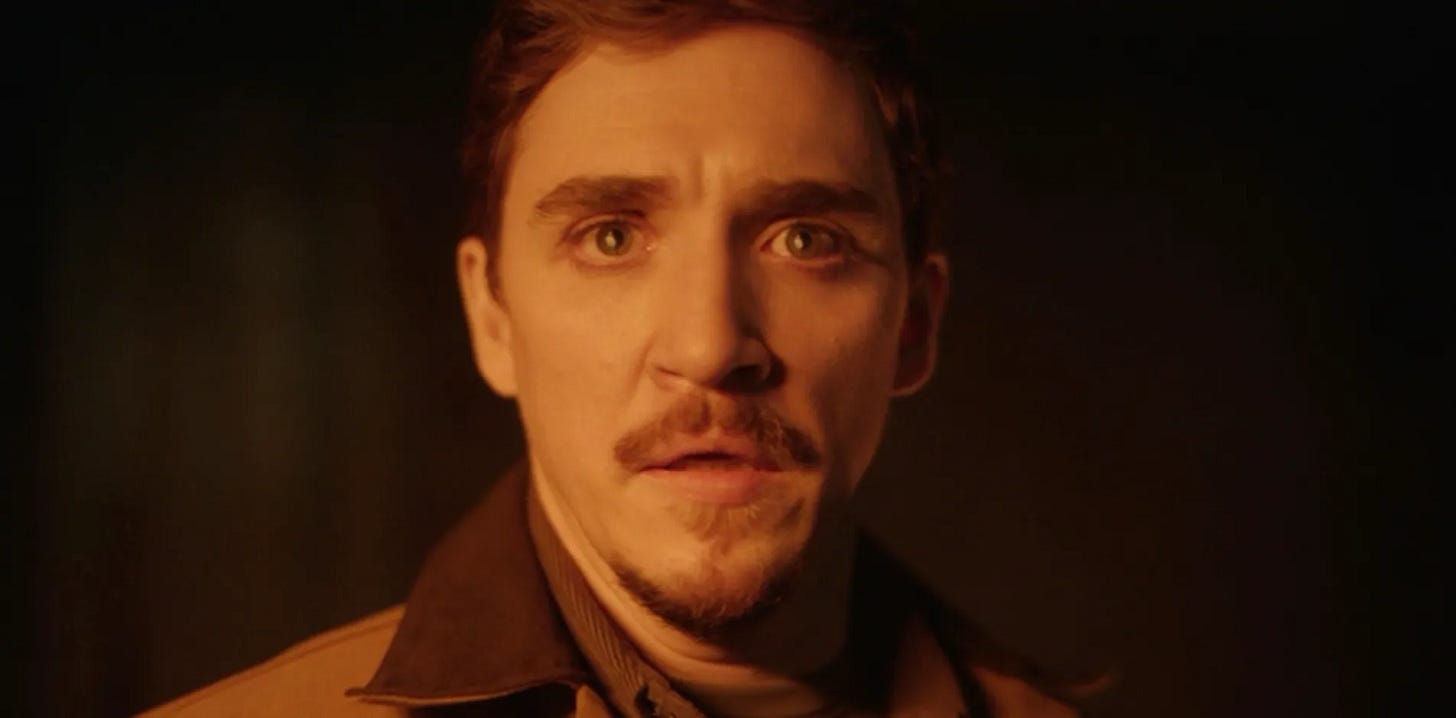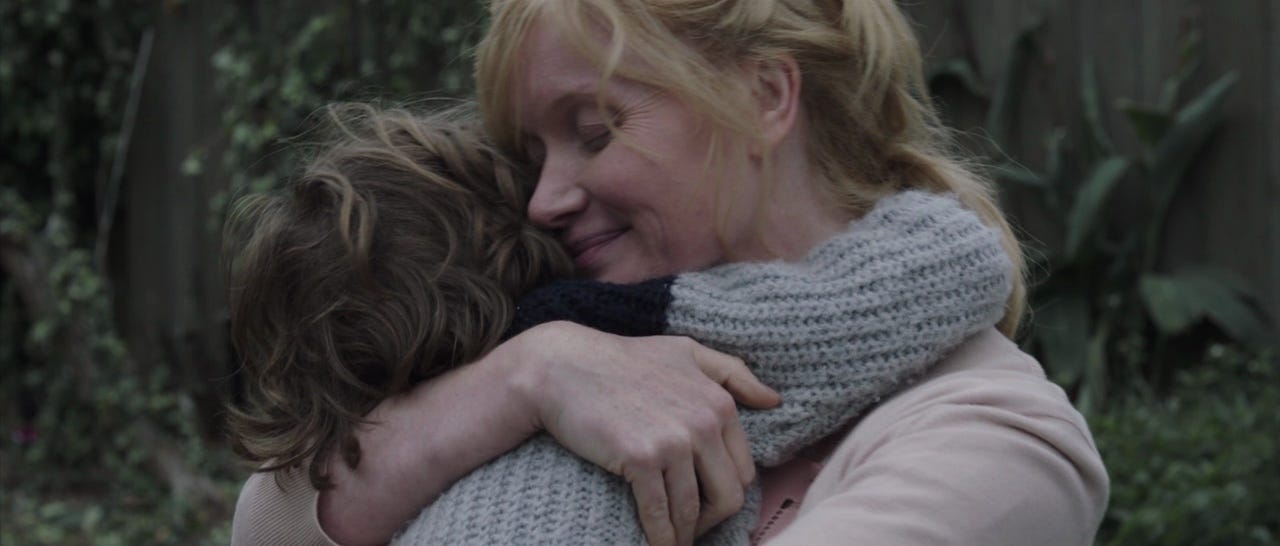The Babadook & Smile: Gendered Trauma
Trauma is now largely discussed amongst mainstream audiences. Let's compare The Babadook and Smile and see how gender fits into the picture.
Welcome back! This is Sara and you’re reading the Crip 101 Newsletter.
As said in the previous issue, the newsletter has become a bi-monthly publication… so here we are! In this month’s one, we’ll delve into Jennifer Kent’s Babadook and Parker Finn’s Smile, two very similar but oh, so different films.
See you on the other side of the divider. 💞 Spoiler alert, obvs.
The Babadook, written and directed by Jennifer Kent.
The Babadook (2014) has come to your favourite movie theatre 9 years ago, but it’s already a cult. Arguably, it has become a cult almost immediately, bringing to the screen horror and guilt with a formula that shows Kent’s incredible cinematography and a structured interest in the themes of trauma, motherhood and blame.
It’s the story of Amelia, a nerve-wrecked mother and widow. Amelia has lost his husband in a tragic car accident, which has left her alone to give birth to her only son, Samuel, and a deep resentment towards the child. Things start to go wrong when Samuel becomes unnerved by a picture book that tells the story of the Babadook, a tall, ominous being that has started to haunt him. By the end of the first half of the movie, Amelia is haunted by the Babadook, too, until he takes over.
Since the beginning of her haunting, it’s clear that Amelia doesn’t like Samuel: she lashes out at him, treats him with contempt and yells at him on any given occasion. Their troubled relationship culminates with the very possession of Amelia by the hand of the Babadook; at that point, Samuel is not in virtual danger anymore but he becomes an immediate target of the beast, who acts via Amelia’s body and her deep resentment towards the boy.
One of the most popular interpretations of the movie regards, in fact, trauma.
Kent’s story is seen as an allegory for the acts and thoughts of a traumatised mind and body, that has to deal with life after death and a sense of guilt. As Paul Mitchell writes, in The Horror of Loss:
“[…], by conveying both the emotional (internal) and physical (external) impact of trauma on her protagonist, Kent’s film provides an interesting example of how cinematic horror is an apposite medium through which to communicate the visceral experience of PTSD. In line with Horvitz’s observation that trauma does not exist as a “unidimensional phenomen[on] that [is] experienced identically by each victim” (2000, 5), it will be argued that, by locating the narrative in a very tangible diegetic space, The Babadook represents Amelia’s PTSD as an idiosyncratic and embodied—rather than purely mental—event.
(Mitchell, 2019)
One sequence, over all the others, tells the spectator how much hatred (towards her son) Amelia has dug inside of herself.
After seeing her dead husband, Oskar, in the basement, Amelia has a sudden realisation: the monster, who has already had full access to her house, is trying to get a hold of her and finally get to the boy. Amelia is terrified and tries to run away from the Babadook: she shuts doors, she crawls on the floor and cries and cannot fathom the idea of letting herself go to those feelings that have clawed at her from the inside out. As seen in the previous part of the movie, Amelia knows she hates her son — she blames him for the death of her husband and is sure that if Samuel had never been conceived, they would have never gone to the hospital that night and been involved in the fatal accident. In her interpretation of the events, her son is the reason why her life has turned into a miserable mess. That is why, at the end of the sequence, the Babadook manages to take control of her body and chase Samuel down.
As stated by Jennifer Kent herself:
“[…] We’re all, as women, educated and conditioned to think that motherhood is an easy thing that just happens. But it’s not always the case. I wanted to show a real woman who was drowning in that environment. I thought that maybe I would be criticised by women, by mothers, because I’m not a mother. The opposite has happened; I’ve experienced a collective sigh of relief that women are seeing a mother up there that’s human. Sure, it’s an extreme situation but what I realise is that a lot of women have felt those feelings that Amelia goes through at some point along the way.”
(The Babadook: 'I wanted to talk about the need to face darkness in ourselves by Paul McInnes, The Guardian, 2014).
For the author, thus, Babadook is also a product of her own need to see more representation of this specific sentiment. But the audience did not limit itself to this interpretation.
After a Tumblr post, back in 2016, the Babadook (the monster) has become a queer icon and started to appear in Pride parades and drag shows as an icon of queer joy and queer representation — a thing that already happened with Frankenstein and Freddy Kruger. Memes have been created and a whole Babadiscourse was born. This tells us not only about the modalities of the screen, in which representation can take improbable and unexpected new paths but also about the deep need for the queer community to find a way to “gain ground”. “I think it’s crazy and just kept him alive. I thought, ‘Ah, you bastard.’ He doesn’t want to die, so he’s finding ways to become relevant” was Jennifer Kent’s comment, as reported by Vanity Fair.
The two readings are, however, not really separated from one another.
In an article published by the New Yorker in 2016, Eren Orbey told about the way in which Kent’s Babadook, and horror movies in general, brought him comfort. Orbey says: “In my own experience, horror movies provided not an example for actions but an outlet for empathy, a chance to see characters contend with a kind of fear that my own peers could not fathom.” Part of Orbey’s trauma came from the murder of his own father, an event that has moulded his future and mind, “cursing” him with a baggage of violence and trauma that he rarely found in the world, as he grew into a man. Nonetheless, in another article published by the same publication, Orbey returns to Babadook to reflect on the monster’s coming out and the way in which the queer community has changed his own perspective on the movie. He says:
“The gay community, witness to so many horrors, is expert at mining spunk and solidarity from what might otherwise seem only tragic. Be gone, grief, the Babadiscourse demands. We’ll take the demon in drag.”
(The Babadook is a frightening, fabulous gay icon by Eren Orbey, The New Yorker, 2017).
Smile, written and directed by Parker Finn.
Finn’s Smile (2022) is a much more recent case. It came out barely last year, but its success is easily comparable with Kent’s Babadook.
Long-form adaptation of Laura Hasn’t Slept (2020) (a short movie by the same writer and director) Smile tells the story of Dr Rose Cotter, who falls victim to a weird, disgusting-looking entity that haunts people and forces them to keep the curse alive by taking their own lives in front of others. A significant detail to keep in mind is that all the involved were previously traumatised.
Smile falls under the category of the curse-themed horror movie, very similar but also deeply distant from Babadook; other examples are The Ring franchise (1998-2017) and It Follows (2014). All these movies put a clear focus on the way in which the entities haunt: they always do it in the same way, they either target specific types of people (people that have witnessed the violent death of someone) or people that have done a certain thing (watched something, had sex) and their thirst is unquenchable. In Smile, Rose is targeted by the entity after a patient (protagonist of the original short film) kills herself in front of her. From there, Rose is forced to learn more about the monster and its curse, until she tracks down the only reported victim who managed to fight back the entity… by killing an innocent person.
At this point in the movie, Rose has two options: either she accepts her fate or she finds another person to sacrifice — and she does find it. In a moment of great crisis, completely isolated by everyone in her life, she goes to the hospital where she works to assassinate Carl (a hospitalised patient), but fails. Rose suffers a long, complex hallucination that tells the viewer that she’s bound to lose the fight against the entity and that she must find another way. In the final act of the film, in fact, Rose decides to face the monster one on one, locking herself in her childhood home — in this way, even if she dies, she won’t curse anyone else.
Unfortunately, this third option that Rose has crafted isn’t as successful as it might appear: after Rose is shown defeating the monster and burning down the house, we follow her to his ex-boyfriend’s house. Note that Joel (the ex-boyfriend in question) is the only ally that Rose has: he still loves her, cares for her and is willing to do everything he can to keep her safe.
As said by Parker Finn himself:
“Horror audiences have gotten so savvy, so I tried to put myself in their shoes,” he says. “What would I be expecting? What would I be anticipating? And I tried to subvert that and do something that might catch them off-guard, and kind of flip them on their heads.”
(Smile director Parker Finn unpacks the movie’s many endings by Tasha Robinson, Polygon, 2022)
And this continuous accumulation of different possibilities and endings does take the audience by surprise but also tells us what is the idea at the base of the entire story.
Interviewed by Variety, main actress Sosie Bacon says:
How do you interpret the movie’s bleak ending?
I don’t think I would have done it if it had a happy ending. That would have been so unsatisfying to me. It was so dark. For it to just be okay would’ve been sad. The positive part is that she did not go for the option where she would’ve had to actually hurt somebody else. She didn’t really have control over it. I think that’s pretty honest. A lot of times people really try their best and do everything that they can, but they don’t have control over the outcome. She tried to defeat it, which I think is really strong. But it was heartbreaking that she ended up passing it to the only person who really cares about her. Yes, it’s tragic, but I think it’s saying that sometimes, even if we try and do everything, trauma can overcome us.
(‘Smile’ Star Sosie Bacon Explains the Horror’s Bleak Ending, Who Killed Her Cat and Her Parents’ Reaction by Jordan Moreau, Variety, 2022).
What Bacon is referring to is the last sequence of the movie: back to reality, Rose realises she has lost her battle with the monster and she is hit with the realisation that each and every one of her attempts to flee the curse has failed; in a gory scene, she is dismembered and possessed and as soon as she is gone, Joel enters the house and witnesses her suicide at the hands of the entity.
This image brings us to the focus point of this issue, which is the deep relationship between the two movies. We have described the main characteristic, plot points and interpretations but what brings these two stories together and what brings them apart?
The future of trauma: how gender intersects storytelling… in the end.
After breaking free from the Babadook and successfully locking him into their basement, Amelia and Sam are free to return to their normal life. In the final sequence, they are confronting two social service officers, explaining Sam’s current situation and the reason why he has been absent from school for two entire weeks. Amelia seems finally calm and collected, serene after the major fight against her own resentment, guilt and pain — and the Babadook, too. She has put together a party for the boy’s birthday (the first since the death of his father): they are ready to celebrate the end of hiding the pain under the carpet!
Right before returning to the party, Amelia needs to go down to the basement and sort the monster out.
Sam: Am I ever going to see it?
Amelia: One day… when you bigger.
(Babadook by Jennifer Kent, 2014)
There, where the monster lives, Amelia brings maggots and worms for him to eat. She looks for him and when the Babadook comes out, growling and snorting, she is startled for a moment. She almost falls over but this time she doesn’t run — on the contrary, she comforts the monster and reassures him that everything’s alright, there’s nothing to worry about. We can easily interpret this scene as a moment of relapse for Amelia: she is celebrating the birth of her son but, coincidentally, she is also mourning the death of her beloved husband. The basement, like the whole house, is an external projection of her internal turmoil… but now, Amelia has grown, and when the pain reemerges, she knows where to hold on to, so that she’s not dragged into the dark again. After this brief encounter, in fact, Amelia returns to her son, compliments his brand-new magic tricks and wishes him a happy birthday.
Kent allows her main character to get to the other end of the grieving process and finally heal: even if she let the Babadook in and almost killed her son as a consequence of it, Amelia can accept the ugly truth and redeem herself from within, accepting what has happened to her and the fact that she will forever be forced to confront her pain. Just like the house, she has not forgotten but she has managed ways to feed her new balance.
Rose, on the other end, is not allowed to heal.
Just like Kent’s film, the ending of Finn’s story is perfectly coherent with the intention of the author, which also transpires in the words of the main actress. Dr Cotter (Rose) is doomed to perish from the beginning. Plus, differently from Amelia, she is physically alone in the final arena (the house) and, while Amelia is offered a way out of the possession, Rose is stripped of it specifically because of the way the monster operates: the smiling entity craves human connection because human connection is what keeps the curse going. There’s no way out of pain and, in a very masculine fashion, connection with the other doesn’t bring comfort or relief but only further suffering.
In Communion. The female search for love, bell hooks writes:
The one person that will never leave us, whom we will never lose, is ourself. Learning to love our female selves is where our search for love must begin. We begin this journey to love by examining the ideas and beliefs we have held about the nature of intimacy and true love. Rather than embracing faulty thinking that encouraged us to believe that females are inherently loving, we make the choice to become loving. Choosing love, we affirm our agency, our commitment to personal growth, our emotional openness.
(hooks, 2002)
hooks bases her argument on the assumption that a woman must love herself in order to find communion with others and that, cursed by a stereotypical “urge to care”, they must exit the role of the inherent caretaker, to find their true selves. Even if I would personally argue that one cannot necessarily learn to love themselves before they love someone else, hooks writing from Communion is particularly useful to put Babadook and Smile in perspective.
For both movies, the gender of the authors (or better, the gendered way they have been socialised) must be taken into account, especially in relation to the ending of their stories. Babadook, even if horrifically soothing, has a happy ending: Amelia has learned to accept herself in accordance with hooks’ interpretation of love and can now love her son; they live in the same faulty house, but they have learned to adapt. Kent believes that the woman can outgrow the pain and live with it, for the sake of transformative love. On the contrary, in Smile, Rose is doomed: she cannot love or forgive her younger self for leaving her mother to die and she cannot connect with others, to hopefully achieve such a goal. The male author doesn’t believe her female character can escape her sin, even if she has tried to compensate for her “mistake” by becoming the ultimate caretaker, a doctor. Finn puts a toxic, masculine lens of pain at all costs onto a picture of great opportunity — he strips the woman of agency and lets her be crushed by her loveless fate.
Sara Giudice
As always, you reached the end! Thank you for dedicating your time to the Crip 101 Newsletter.
This is a 0-budget project that I handle completely alone. Please, consider sharing it with someone you think might be interested. Every interaction counts and I am so very grateful for every single one of them.
See you next time, folks.










